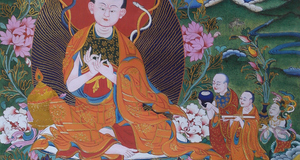Understanding Nirvana in Theravada and Mahayana Buddhism: In Support of Nagarjuna's Mahayana Perspective
By
2016, Vol. 8 No. 02 | pg. 1/1
IN THIS ARTICLE
KEYWORDS
The path towards and the meaning of Nirvana have been central issues to many theorists of the Buddhist Tradition. With this paper, I will describe the path toward and the state of Nirvana from a Theravada and Mahayana Buddhist perspective. By doing so, I hope to show that Mahayana Buddhism’s view of Nirvana, or the altruistic compassion that results from one’s spiritual flawlessness in this life, outdoes the Theravada belief that once a person reaches Nirvana any facet of the human condition can no longer phase them.1 Finally, by drawing on the writings of Nagarjuna, I argue that his Mahayana understanding of Nirvana is more inline with the teachings of the Buddha than that of the Theravada School. Photo: Jan Kromer ND-2 Nirvana in Theravada BuddhismAccording to Theravada Buddhists, one can achieve the serenity of Nirvana, or liberation from the agonizing effects of desire, by dedication to the abandonment of the distractions of life.2 In order to do so, the Buddha recommends that one should discipline their mind and body.3This is because the results of practicing self-discipline can help to lead one to conquer themselves and come to know the everlasting bliss and contentment that are characteristics of the state of Nirvana.4 To quell various forms of desire, and the suffering they produce, one should apply temperance to all they do.5 As the Buddha instructs, one who is temperate and does not enjoy excess is closer to Nirvana because by not being overly attached to the world, one gains genuine insight into its underlying nature.6 As the Buddha instructs, one who is temperate and does not enjoy excess is closer to Nirvana because by not being overly attached to the world, one gains genuine insight into its underlying nature. This underlying nature, the inherent suffering within all that exists due to the ceaseless cravings of all sentient beings, should be fought through inner resolve. Inner strength not only draws one nearer to Nirvana – the highest achievable spiritual end – but it can also help one realize their own inner being in the process.7 The value of this self-awareness is its use as an indispensable tool to assist one to not stray from the path towards Nirvana, since the power of self-knowledge can prevent one from falling into the depths of hate or ignorance.8 Also, to the Buddha, a cultivated mind is precious because it is marked by a lack of perplexity, which allows one to focus on detaching from their worldly wants in an easier way.9 Likewise, one who restrains themselves from excessively pursuing bodily pleasures can attain the cessation of desire, or Nirvana, because not only does a well-disciplined body allow one to pursue Nirvana with greater ease, it also habituates one to behave in a way that is against their own suffering.10 In other words, the Buddha, who recommends one to refrain from ill-speech, too much food or drink, anger, and other bodily extremes, can be understood as supporting the idea that through self-cultivation, one can continually lessen the grip their passions hold over them, and in turn, reach Nirvana. In Theravada Buddhism, Nirvana is the consequence of one’s dedication to extinguishing desire.11 Consequently, Nirvana is not only a state of liberation from wants, but also a freedom from the suffering that is associated with them.12 To Theravada Buddhists, self-knowledge is a tried and true path to this unutterable state of being, and by understanding that all things are ephemeral and ever-changing, one can begin to comprehend, in their own way, how they may cultivate Nirvana within.13 This is because, when one realizes their existence is only a moment in comparison to all of time, they may begin to embrace a more humble disposition, which is akin to the frame of mind needed in order to reach Nirvana.14 In Theravada Buddhism, Nirvana is not only a state of liberation from wants, but also a freedom from the suffering that is associated with them.
Hence, the inherent instabilities of life may provide one with an insight into how they should live, which can come by practicing detachment from the world, in order to escape its vicious cycle of suffering. Furthermore, Theravada Buddhists tend to believe that Nirvana, by being the dissolution of all the qualities one possesses in this life, is easier to achieve upon or after death.15 This is important to note, because it can lead one to infer that the cessation of their being, or death, may be the surest way for them to escape this world of constant pain.16 Yet, at the same time, Theravada Buddhists do believe there is a path to Nirvana in the here and now, and they seem to support the idea that it is achievable through a diligent application of the Eightfold Path, or the eight Buddhist virtues that should be cultivated so that one may live contently.17 Theravada Buddhists stress that Nirvana is to be in touch with one’s condition and that of the world, yet at the same time they should refrain from identifying with the plight of either.18 This is because of the insights one can gain during their journey towards Nirvana, which can subsequently help them understand that the mind and body are in a constant state of flux, and hence, no one can truly claim to be a static or fixed being. Finally, since there is believed to be an inherent instability within all that exists, one should practice being an impartial spectator towards life, because with this attitude, one can in turn, come to a state of being that is unmarked by the impure effects of this world, or Nirvana. Nirvana in Mahayana BuddhismOn the other hand, the Mahayana tradition of Buddhist thought believes that those who sincerely seek liberation and spiritual awakening can follow the path towards Nirvana with greater ease than those who choose to remain in ignorance.19 By genuinely wishing to gain a deeper connection with all that exists, one can more adequately ignore their wants, and in turn, make room to develop a true sense of compassion for all beings.20 In order to reach Nirvana, Mahayana Buddhists believe that one should imitate the life of the Buddha, and in turn, attempt to become a bodhisattva, or one who is in the process of attaining enlightenment as the Buddha did during his lifetime.21 This is important because by believing that one may reach the same level of awareness as the Buddha, while alive, Mahayana Buddhists clearly distinguish themselves from the Theravada school in their belief that Nirvana is easier to achieve upon or after one’s death.22 Hence, one may infer that to Mahayana Buddhists, devotion is a central tenet and practice one can use to reach Nirvana in the here and now.23 Furthermore, if one is selfless, self-sufficient, and detached from the shackles of life, Mahayana Buddhists believe that treading the path toward Nirvana gradually becomes easier.24 Mahayana Buddhists believe Nirvana lies in imitating the life of the Buddha. As one more fully realizes the ideals of selflessness, self-sufficiency, and detachment, treading the path toward Nirvana in the here and now becomes gradually easier. I believe this is due to the Mahayana view that Nirvana is an all-encompassing domain that all beings reside within, and therefore, by being self-sufficient, yet selfless, as well as detached, yet altruistic, one is truly imitating the totality of all things that make up Nirvana, or following what is called the Middle Path.25 To Mahayana Buddhists, the Middle Path is the belief that all things are interdependent and because of this, one should be moderate in all that they do. Yet, this cannot be equated to the Theravada belief in the diligent practice of temperance. While the Theravada school supports the practice of temperance so that one can detach from the world, the Mahayana tradition believes that moderation imitates the impartial nature of the Buddha, or the preeminent one who has achieved Nirvana, which in turn can help others attain spiritual emancipation. To Mahayana Buddhists, Nirvana is not only a state of spiritual flawlessness, but also the reality that all sentient beings are a part of.26 Furthermore, to Mahayana Buddhists, Nirvana is a state of spiritual perfection in which one realizes that there is nothing outside of Nirvana, and that it is the highest degree of reality one can enter into.27 Unlike Theravada Buddhists, the Mahayana School stresses that aside from Nirvana being an absence of suffering, it is also a realization that all sentient beings are interconnected and nothing that exists is spared from nature’s processes.28 In other words, by being within the natural order, people, like any other sentient being, will experience pain, and those who have reached Nirvana realize that suffering is just as natural as any other facet of life.29 In contrast to the Theravada concept of spiritual liberation, the Mahayana school believes that Nirvana cannot really exists until all have reached it.
Consequently, the Mahayana Buddhists believe that this can lead one to be disenchanted with Nirvana, which is problematic because feelings of dissatisfaction are contrary to that state of contentment. Hence, this paradox leads the Mahayana, unlike their Theravada brethren, to recommend that those who are in Nirvana assist those who have not yet reached it.30 This is because, by helping others reach Nirvana, one, like the Buddha, lessens suffering, and in turn, helps facilitate all people to become part of this ineffable state of bliss. The Mahayana tradition believes Nirvana is the cessation of one’s belief that they are a distinct and unique individual, which may heighten one’s concern for humanity as a whole, due to their having transcended the illusions of separation and duality.31 Finally, in contrast to the Theravada concept of spiritual liberation, the Mahayana believes that Nirvana cannot really exists until all have reached it.32 The Buddhist philosopher Nagarjuna believed that Nirvana was beyond logic. To him, the closest one can come to describing this level of reality is to understand that it derives from neither existence nor non-existence.33 He believes that Nirvana, by not having origination, cannot come to pass, and because of this it follows that by being beyond the scope of existence or non-existence, Nirvana is ultimate reality.34 Hence, by being an exception to the interactions between being and non-being, Nagarjuna is left to conclude that Nirvana is the all-encompassing totality of reality that all sentient beings reside within.35 In this view, the very concept of Nirvana can be misleading when taught because the more accurate meaning of Nirvana, as according to the Middle Path, is that it is a state of tranquil disinterestedness, or blissful emptiness, and not one that results from only devotional acts.36 Instead, he believes that Nirvana is reached by ceasing to desire it, because by doing so, one can further let go of who they are, in order to mature into a state that is a balance between that which exists and that which does not.37 Furthermore, Nagarjuna states that because there is really no definition that is adequate to describe Nirvana, one should discard it from thought so that it does not become a source of vexation.38 Consequently, though this vexation can lead one to stray from maturing into Nirvana, one can also subdue this frustration by mimicking emptiness.39 Hence, one can infer that to Nagarjuna, though Nirvana is not to be pursued, it can nevertheless be attained by imitating the stillness that is characteristic of it. Finally, by focusing on balance, one can infer that Nagarjuna’s teachings are more in line with the Mahayana Tradition of Buddhism, rather than the tradition of the Theravada School. The Mahayana Tradition: True to the Teachings of the BuddhaI believe Nagarjuna’s Mahayana view of spiritual liberation is more attune to the teachings of the Buddha than the Theravada School’s understanding of Nirvana. I make this claim because, like the Mahayana, Nagarjuna believes that Nirvana is a state of realization in which one indescribably knows they are and were always in union with the all-encompassing universe, or Nirvana, which is similar to the Buddha’s statement that the universe is all-embracing and that upon reflection, one may realize that they are already in Nirvana.40 This is in contrast to the Theravadas’ focus on detachment from the world for one’s own sake, in order to transcend the conditions imposed on them by this life of desire, as a way to gain Nirvana. One may infer, as a result, that to Theravada Buddhists one should try to escape the painful predicament of this life, through only self-denial, which I believe the Buddha, Nagarjuna, and the Mahayana Tradition would not identify with. Ultimately, Nirvana facilitates desire, and since desire derives from Nirvana, there is something good in it, insofar as it can help one to learn valuable life lessons. Nagarjuna, who claims that the universe is dynamic and not subject to the laws of origination or annihilation, may rightfully be understood as supporting a similar claim that was made by the Buddha in The Parable of the Mustard Seed.41 This is because, to the Buddha, the universe, or Nirvana, does not fully possess being or non-being and because of this, all things are impermanent, which should encourage one to follow a middle route between the extremes of participation and detachment from the world.42 Not only has this claim influenced the Mahayana School and Nagarjuna, it is also evidently different than the Theravada’s focus on self-centered asceticism as the surest way to Nirvana. According to the Buddha, one must accept that Nirvana is at times a painful condition, which all people are a part of, and that by helping others from a place of genuine compassion can, in turn, help them to realize the preexisiting state of Nirvana.43 This is similar to Nagarjuna’s belief that compassion is part of the practice of the Middle Path because it is a means to help those who are not yet aware of Nirvana to realize a new level of consciousness, as well as to emulate its essence of emptiness. Finally, this too diverges from the Theravada belief that one must achieve Nirvana instead of growing into it as a state of being. ReferencesBurtt, E.A. ed., The Teachings of the Compassionate Buddha (New York: Mentor Books., 1955). 11-241 Endnotes
Suggested Reading from Inquiries Journal
Inquiries Journal provides undergraduate and graduate students around the world a platform for the wide dissemination of academic work over a range of core disciplines. Representing the work of students from hundreds of institutions around the globe, Inquiries Journal's large database of academic articles is completely free. Learn more | Blog | Submit Latest in Theology |

















